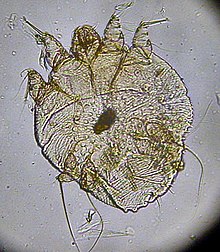Sarcoptes scabiei
| Sarcoptes scabiei | |
|---|---|
 |
|
| Scientific classification | |
| Kingdom: | Animalia |
| Phylum: | Arthropoda |
| Class: | Arachnida |
| Subclass: | Acari |
| Order: | Sarcoptiformes |
| Family: | Sarcoptidae |
| Genus: | Sarcoptes |
| Species: | S. scabiei |
| Binomial name | |
|
Sarcoptes scabiei (Linnaeus, 1758) |
|
Sarcoptes scabiei or the itch mite is a parasitic arthropod that burrows into skin and causes scabies. The mite is found in all parts of the world. Humans are not the only mammals that can become infected. Other mammals, such as wild and domesticated dogs and cats (in which it is one cause of mange) as well as ungulates, wild boars, bovids, wombats, koalas, and great apes are affected.
The discovery of the itch mite in 1687 marked scabies as the first disease of humans with a known cause. The Italian biologist Diacinto Cestoni showed in the 18th century that scabies is caused by the mite Sarcoptes scabiei, variety hominis. The disease produces intense, itchy skin rashes when the impregnated female tunnels into the stratum corneum of the skin and deposits eggs in the burrow. The larvae, which hatch in three to 10 days, move about on the skin, moult into a nymphal stage, and then mature into adult mites. The adult mites live three to four weeks in the host's skin.
The action of the mites moving within the skin and on the skin itself produces an intense itch that may resemble an allergic reaction in appearance. A delayed type IV hypersensitivity reaction to the mites, their eggs, or scybala (packets of feces) occurs approximately 30 days after infestation. The presence of the eggs produces a massive allergic response that, in turn, produces more itching. Individuals who already are sensitized from a prior infestation can develop symptoms within hours.
...
Wikipedia
